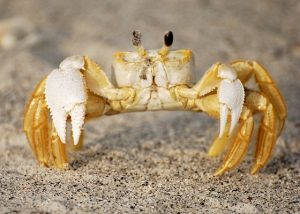What Is a Ghost Crab?
It is a type of crab of genus Ocypoda that can be seen crawling along sandy shores in many parts of the US and Brazil. As expected, it is a member of the Decapod species. It is commonly seen in shores in many countries.
Names
This animal is also known as “Sand Crab” or “White Crab”. These are also known as “Mole Crabs”.Description
This animal has a pale body color that is similar to the color of sand. This makes it nearly invisible when it crawls about over sand. It is because of this apparent invisibility that the crab has got its unique name. The name is also suggestive of the fact that the activities of this creature are mainly restricted to night.Body
This animal has five pairs of legs. The first pair is called Chelipeds and is shaped as claws. The legs, when jointly used, can make crabs move in any direction – forward, backward or sideways. In male crabs of this specie, one claw is slightly larger than the other.Eyes
It has large black eyes that are supported on stalks. Its eyes help it see in any direction. There are horns attached to the end of the eyes of male crabs. It is by these horns that the gender of a crab is recognized. The eyes of these creatures are sensitive to changes in light.Vision
The large eyes of these crabs give them a wide field of vision. The eyesight of these creatures is very good. This helps them spot predators very quickly and find out any other threats.Length
It is about 2-3 inches in size.Anatomy
It has a water-tight exoskeleton (external skeletal structure) which prevents the creature from becoming dry. The body covering also lends support to its muscles and organs.Shell Shedding
With increasing maturity, the crab begins to lose its external skeleton. It comes off at a point, only to be replaced by a new, slightly larger shell. The new shell takes some time to harden and until that happens, the crab remains vulnerable.Habitat
This creature is found in sandy beaches of tropical as well as subtropical coasts. It can be found anywhere from the American Atlantic Sea, Mediterranean Sea and Red Sea to coasts along the American Pacific and the Indo-Pacific.Location
These crabs are usually found in sandy beaches and backshores where they live in burrows. Crabs usually burrow a deep hole to keep themselves cool during daytime. They remain in burrows during daytime and when winter is at its coldest.Diet
It is omnivorous, meaning it feeds on both animals and plants. It can also devour other crabs and detritus. The creature feeds on snails, clams, turtle hatchlings, lizards and small crabs. Ghost Crab foods also include organic matter.Characteristics
The crab can move on sand at about 10 miles per hour and is able to change is direction suddenly.
Burrows
It burrows into the sand at a 45 degree angle for a depth of up to 4 feet. It creates holes of 1-2 inch width. Adult crabs of this family occasionally dig a burrow with two entrance shafts.The digging actoivotoes of these crabs have been reportedly heard even 2 meters (6 inches) away.
More information from the entire article can be found here:
www.animalspot.net/ghost-crab-sand-crab

"SAND CRABS!!!"
ReplyDelete'Back when I first went aboard the USS Princeton LPH-5 in Aug of '67 She was just getting ready to go into "Dry Dock, Pier 5, Naval Shipyard Long Beach, Ca." Once we got settled into the "Dock" that's when all the "Sand Crabs"(Yard Workers) took over!! they were everywhere!! into everything!! Ya' had to hide everything that you didn't want to get violated...the "Sand Crabs" would eat the rotting flesh off 2 week old Col. Sanders chicken if they could find it!! 'Ya think I'm Kidding???? hehehehehe,..."NO!!" ....OH those were the daze!!
PR-2, USS Princeton LPH-5.....Viet Nam '68.
Got Gunz.......OUTLAW!!!!,
skybill-out
"SAND CRABS!!!"
ReplyDelete'Back when I first went aboard the USS Princeton LPH-5 in Aug of '67 She was just getting ready to go into "Dry Dock, Pier 5, Naval Shipyard Long Beach, Ca." Once we got settled into the "Dock" that's when all the "Sand Crabs"(Yard Workers) took over!! they were everywhere!! into everything!! Ya' had to hide everything that you didn't want to get violated...the "Sand Crabs" would eat the rotting flesh off 2 week old Col. Sanders chicken if they could find it!! 'Ya think I'm Kidding???? hehehehehe,..."NO!!" ....OH those were the daze!!
PR-2, USS Princeton LPH-5.....Viet Nam '68.
Got Gunz.......OUTLAW!!!!,
skybill-out
LOL! But yours those were the two-legged type, Skybill! :o)
ReplyDelete